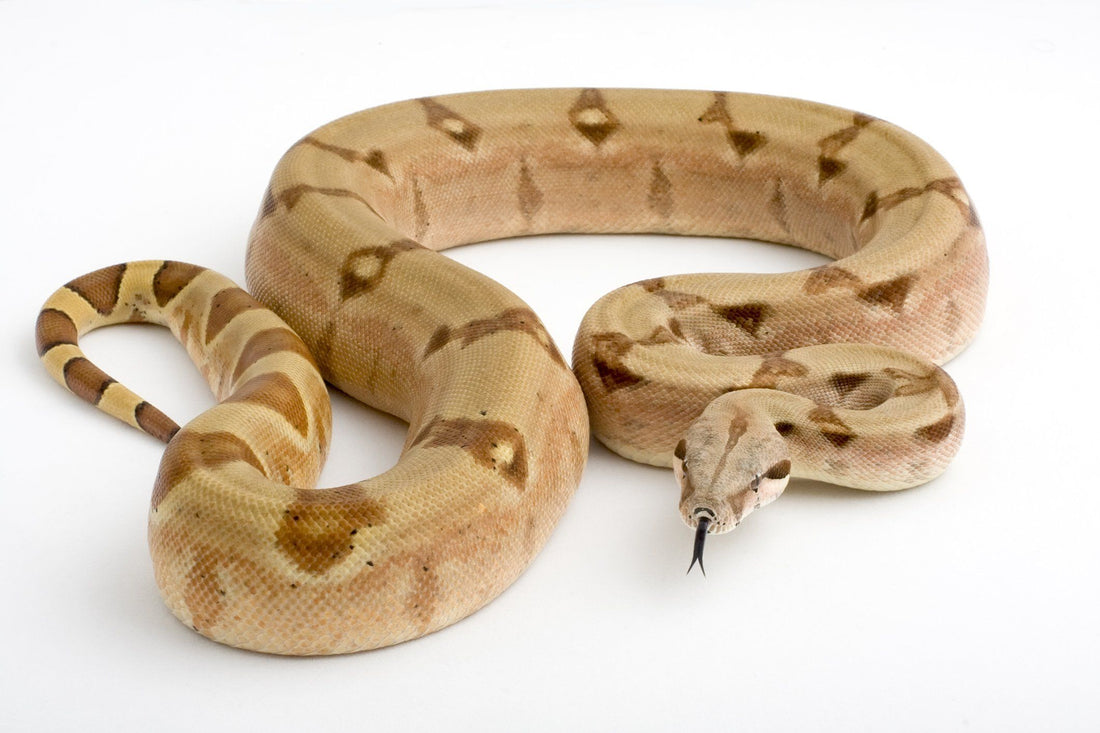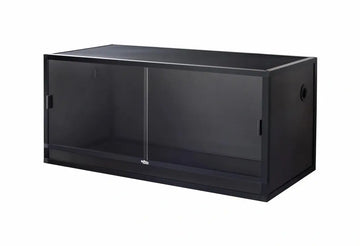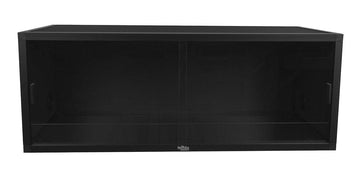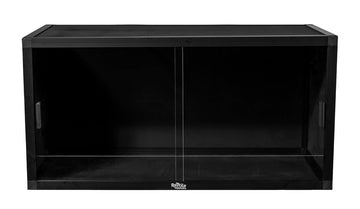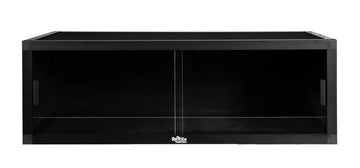Table of Contents
Introduction
Boa constrictors (Boa sp.) are a group of 5-12’ long, crepuscular, semi-arboreal snakes native to Central and South America. They prefer subtropical to tropical forest habitats and spend time in trees and on the forest floor.
Depending on the species, Boa constrictors vary widely in color, pattern, and size. Captive breeding efforts have produced morphs, which increases the available variety further. However, generally speaking, boa constrictors have muscular, rectangular bodies, rectangular heads, prehensile tails, and darker patterning on their tails compared to the rest of their body.
Boa constrictors are among the most common pet snakes in the US due to their hardiness and tolerance toward humans. However, their size and husbandry requirements still make them intermediate- to advanced-level pet reptiles. With good care, they are capable of living 30 years or more.
How to identify different types of boa constrictors:
Most pet boas are either Boa constrictor constrictor (BCC) or Boa imperator (BCI), but there are several other types.
- Bolivian Silver Back/Short Tail Boa (Boa constrictor amarali): Found around southeast Bolivia and southern to southwest Brazil. It averages 5.5-7’ long—identifiable by silver to silvery-tan based color with black, bat-shaped saddles.
- Red-Tailed Boa (Boa constrictor constrictor): Found in South America east of the Andes mountain range. It averages 7-10’ long. Identifiable by yellow to brown base color, red to reddish-brown tail markings, and dark bat-shaped saddles and spotting.
- Peruvian Long Tail Boa (Boa constrictor longicauda): Found in northern Peru. It averages 6’ long. Identifiable by black and white or black and gold color, with a spear-shaped marking on top of the head.
- Clouded Boa (Boa constrictor nebulosa): Found in Dominica. It averages 10’ long. Identifiable by a gray-brown base color, spotted belly, and low-contrast pattern.
- Argentine Boa (Boa constrictor occidentalis): Found from Argentina to Paraguay. It averages 10’ long. Identifiable by dark brown/black base color with a lighter pattern.
- St. Lucia Boa (Boa constrictor orophias): Found on St. Lucia island. Grows 10-12’ long. Identifiable by a gray-brown base color, darker brown saddles, and black tail markings.
- Macanche Boa/Orton’s Boa (Boa constrictor ortonii): Found in Peru. It averages 9’ long. Identifiable by brown to gray-brown base color and low-contrast pattern with dark outlines.
- Pearl Island Boa (Boa constrictor sabogae): Found around the Pearl Islands. Beige-brown to pink base color with incomplete saddle markings. It averages under 6’ long.
- Central American Boa/Common Boa (Boa imperator): Found in Mexico, Central America, and west of the Andes. It averages 5-7’ long.
- Sonoran Boa (Boa sigma): Found in western coastal Mexico. Identifiable by brown base color with lighter spots and circles.
PLEASE NOTE: This care sheet contains only basic information for Boa Constrictors (BCC/BCI). Continue your research with high-quality sources. Due to the many subspecies, we recommend additional in-depth research for your specific animal. Care and dietary requirements may vary.
Enclosure
Minimum terrarium size for boa constrictors
Due to the variation in size between different types of boa constrictors, knowing precisely what species (or subspecies) of boa you have to predict its adult length and choose an appropriately-sized enclosure accordingly is essential.
For boa constrictors, we suggest an enclosure that is at least as long and wide as their expected adult length. Boas are typically active and utilize ample vertical and floor space, so we recommend opting for a larger habitat. In short, we find that bigger is better! However, remember that the ideal living conditions for boas will vary based on their needs and preferences. It is important to understand your specific animal to determine the best set-up.
Can boa constrictors be kept together?
We do not recommend cohabitation (keeping multiple boas in one enclosure).
How to quarantine a boa constrictor
When you bring home a new pet reptile, it’s best practice to quarantine it first, especially if you own other reptiles.
Quarantine is the practice of isolating animals that have arrived from elsewhere or been exposed to infectious or contagious disease.
Even if you don’t have other reptiles, quarantine is still crucial because it allows you to closely monitor your snake for signs of illness and administer treatment. You can use your boa constrictors’ long-term enclosure for quarantine or a large plastic tub. Tubs are inexpensive and easy to clean, making them the go-to option for quarantine.
Here are some general rules for quarantining your boa constrictors:
- Keep the snake in a different room from other reptiles, if possible.
- We suggest using different equipment for your new boa constrictors and washing your hands thoroughly between handling other animals.
- Thoroughly disinfect the enclosure often; we suggest doing this about one time per week.
- If needed, get the boa constrictors checked by an experienced reptile veterinarian and treated for parasites.
- Monitor your new pet closely and watch for any symptoms of illness or disease.
- Check your snake and its water bowl closely for mites, especially if the snake is soaking. If you do find mites, treat them accordingly.
Lighting
Do boa constrictors need UVB?
While boa constrictors can survive without UVB lighting, we recommend providing it. UVB lighting helps give a clear day/night cycle, provides all of the vitamin D your pet needs, strengthens the immune system, facilitates better digestion, and other benefits.
We recommend the following UVB bulbs for boa constrictors:
- Zoo Med Reptisun T5 HO 5.0
- Arcadia Forest 6%
The bulb you buy should be approximately half the length of the enclosure. For best results, house the UVB bulbs in a reflective fixture. Position the lamp on the same side of the terrarium as the heat lamp, about 11-13” above the basking area if over the mesh and 14-16” above the basking area if not.
UVB is blocked by glass and plastic, so placing the terrarium in front of a window doesn’t count as “free UVB” — it can make your terrarium too hot due to the greenhouse effect. Don’t forget to replace your bulb every 12 months!
We suggest leaving lights on for about 8-12 hours daily to follow a natural day-to-night cycle. You can also adjust the lighting based on seasonal changes, running it for more extended periods during the summer and shorter periods during the winter. All lights should be off at night.
Heating
The best temperature for boa constrictors
Like other reptiles, boa constrictors are cold-blooded, which means they rely on external temperatures to manage their body temperature and metabolism. A reptile’s enclosure should offer a range of temperatures to allow them to thermoregulate effectively.
Specifically, most boa constrictors should have a basking temperature of 86-90°F and a cool side ambient temperature between 75-80°F. Each reptile may have different preferences and needs, so you may need to adjust these ranges up or down slightly to accommodate your pet better. It is good practice to monitor your animal and make adjustments as needed.
We suggest using a temperature gun to measure basking/surface temperatures and digital probe thermometers to measure ambient air temperatures. Different subspecies may have other heating requirements, so it is essential to research your specific animal thoroughly.
Overhead heating methods, such as halogen bulbs, are recommended to achieve and maintain these temperatures. However, some may opt for alternative methods such as radiant heat panels or deep heat projectors.
It is essential to regulate and monitor the temperature of the heating method chosen. To do this, we suggest using a thermostat, dimmer switch, or rheostat to control the heat output.
Providing your boa with the appropriate temperature range will ensure your pet is healthy, comfortable, and able to carry out necessary biological processes effectively.
Humidity
Best humidity levels for boa constrictors
We find that boa constrictors do best with about 55-75% ambient humidity levels.
You can measure humidity with a digital probe hygrometer, placing the probe in the middle of the terrarium. This device will allow you to keep track of the humidity levels and adjust as needed to ensure that your boa constrictor is in a comfortable and healthy environment.
One effective method to increase humidity levels in your boa's enclosure is misting the enclosure with a spray bottle once or twice a day. Misting the enclosure first thing in the morning and again at night, if necessary, is recommended. Another way to maintain humidity levels is by mixing water directly into the substrate on one side; this will help retain moisture and prevent the enclosure from becoming too dry. You can also provide your snake with a third humid hide lined with moistened sphagnum moss.
Different subspecies may have varying humidity requirements, so it is essential to research your specific animal thoroughly.
How to create a humid hide for your boa constrictor
We suggest adding a third humid hide in addition to the warm and cool hides, which should be placed towards the middle to cool end of the enclosure. Providing your boa with access to a humid hide is a great way to ensure your boa will be able to stay well-hydrated and shed more easily. This hide should function as a humid burrow to which your boa can retreat whenever it needs a bit of extra moisture.
There are various options for purchasing a humid hide, such as the Zilla Rock Lair or the Exo Terra Snake Cave. These products are fully-enclosed and easy to clean while your boa is smaller. Alternatively, you can make a humid hide using a Tupperware container with a hole cut out for an entrance. Whether you purchase or create a humid hide, line these with a moistened paper towel or sphagnum moss.
Replace paper towels every 1-3 days or when they are soiled. Replace sphagnum moss every 2-4 weeks. Providing your boa with a humid hide and regularly maintaining it can help ensure your pet stays healthy and comfortable.
Substrate
Naturalistic Options
Choosing a suitable substrate is essential when creating a comfortable and healthy habitat for your boa. A great option is to provide a thick layer of natural substrate (bedding), which can cushion and help maintain humidity levels while enhancing the enclosure's overall appearance. We recommend the following substrates for boas:
- Zoo Med Eco Earth
- Zoo Med ReptiSoil
- Exo Terra Plantation Soil
- Zilla Jungle Mix
Substrate mixes are also a great option. You can mix several commercial substrates or create a mixture using a combination of organic topsoil, play sand, and moss. Other self-made mixture options are possible, and you should research the subject and ratios thoroughly before starting your custom mix.
Layering clean, chemical-free leaf litter on the substrate can also help with humidity.
Ideally, the substrate should be at least 4” deep and completely replaced every 3-4 months. Remove poop and urates daily, along with any contaminated substrate.
Paper Towels
While various substrate options are available for boa enclosures, some keepers prefer to use simpler substrates, such as paper towels. These can be an effective and easy-to-maintain option for keeping your snake's enclosure clean and is especially significant when your snake is still in quarantine.
However, it is essential to remember that using paper towels as a substrate requires more frequent replacement than other options. Paper towels can quickly become soiled and develop mold if left unchanged for too long. Therefore, regularly replacing the paper towel substrate is recommended to keep your boa's enclosure clean and prevent mold growth.
Ultimately, the choice of substrate for your boa's enclosure will depend on your personal preferences and your pet's needs. Regardless of which substrate you choose, it is important to maintain it properly to ensure your boa stays healthy and comfortable.
What to know about cleaning a boa constrictor enclosure
Replacing your boa’s substrate is a good time to give the entire enclosure a good cleanout. Here are some general steps to follow:
- Remove your snake from the enclosure and put it inside a temporary, escape-proof holding container. This container should offer a hide, a small water bowl, and a thin layer of the old substrate from the enclosure for the snake’s comfort.
- Remove all substrate and decor.
- Vacuum and wipe down the enclosure to remove leftover particles.
- Apply a reptile-safe disinfectant to the floor and walls of the enclosure and let it sit for the disinfectant’s recommended contact time.
- Meanwhile, soak branches, rocks, hides, and other decor items in a disinfectant rated for porous materials for the recommended contact time.
- If required, rinse the enclosure and the accessories with clean water to remove disinfectant residue. Allow everything to dry.
- Pour new substrate into the enclosure. Mix in water until uniformly moistened but not wet.
- Arrange décor. If your boa is easily stressed by change, put everything back where it was before.
- Reintroduce your snake to the clean setup.
Several veterinary-grade disinfectant options are available that are effective for both porous and nonporous materials, such as Chlorhexidine, F10SC, and CleanBreak. It is essential to carefully follow the instructions on the packaging to ensure safe and proper use. Alternatively, you can disinfect enclosures by using a diluted bleach solution. For porous materials, a 1:10 dilution is recommended, while for nonporous materials, a 1:50 dilution should be used.
Can bioactive work for boa constrictors?
Absolutely. Bioactive vivariums can be a good choice of housing for boa constrictors because they are conducive to higher humidity levels and provide plenty of foliage in the higher levels of the enclosure. Bioactive vivariums have the additional benefit of eliminating the need for total cleanouts, and a healthy vivarium always has a fresh, earthy aroma.
Some downsides of bioactive set-ups for boa constrictors are that they require at least one month to get established before the snake is introduced, the plants that you use need to be sturdy enough not to get crushed, and bioactive is usually more expensive to set up in the short-term. CUC (Clean Up Crew) organisms may occasionally escape, and maintenance in the form of plant care and occasional partial soil replacements are still necessary.
If you want to put together a bioactive setup for your boa, you will need all of the supplies recommended in this article, plus a few more things:
- bioactive-ready substrate mix
- clean leaf litter
- sturdy live tropical plants that can withstand occasional snake traffic
- 6500K LED or fluorescent grow lamp, spanning most of the enclosure’s length
- tropical CUC organisms to maintain the soil
While it’s possible to mix a temperate bioactive substrate, if this is your first attempt at bioactive, you’re most likely to have success if you use a pre-mixed bioactive substrate available commercially.
Good options for CUC for a bioactive boa constrictor vivarium include dwarf white isopods, powder orange/blue isopods, and springtails.
Décor
How to decorate a boa constrictor terrarium
We have found that providing environmental enrichment for your boa constrictor can significantly improve its quality of life by keeping it stimulated and engaged. Adding carefully selected décor items can encourage natural behaviors and exercise, leading to a happy and healthy pet.
Since boa constrictors are semi-arboreal, we suggest at least two hiding places on the ground, a branch to climb on, and foliage to hide in off the ground. We find that the more clutter and climbing opportunities, the better! Some great options to include in your enclosure are:
- more branches
- thick, braided vines
- cork tubes/hollow logs
- ledges
- live or artificial plants
Live plant options for boa constrictors
Boa constrictors may not be as thick as pythons. However, they are still larger, heavy-bodied snakes, so they can easily accidentally crush live plants in their enclosure — particularly the larger subspecies and localities. That means that you must be careful in selecting plants most likely to resist occasional trampling and climbing. Here are some plants that are robust and do well in a moderately humid, moderately-lit environment:
- Dracaena
- Ficus
- Peperomia
- Philodendron
- Pothos
- Schefflera
- Spider plant
Larger, older plants are more expensive to buy but sturdier and more likely to survive your boa.
Food
What to feed to a boa constrictor
Boas are carnivorous, meaning they must eat whole animal prey for proper nutrition. Here is a basic feeding schedule based on snake age:
- Newborn-12 months: every 10-12 days
- 12-18 months: every 12-14 days
- 18-24 months: every 2-3 weeks
- 2-2.5 years: every 2-3 weeks
- 2.5-3 years: every 3-4 weeks
- 3-4 years: every 4-6 weeks
- 4+ years: every 4-8 weeks
Prey items should be around 10% of the snake’s weight and no more than 1.5x its width at its widest point. You can choose to feed live or frozen prey. We recommend using frozen/thawed rodents when possible, as they are easier to find and store while eliminating the risk of the prey injuring your snake. If you choose to feed live prey, we strongly recommend monitoring your snake during feeding so that you can quickly remove the rodent if needed. Frozen prey should be thawed in a BPA-free plastic bag in warm water until it reaches ~100°F. Use a pair of soft-tipped feeding tweezers to offer it to your snake.
One of the keys to great nutrition is variety, so aside from offering mice and rats, quail, chicks, and quail eggs can also add diversity to your snake’s diet.
Where to get feeders for your snake
Most pet stores sell frozen mice and rats in various sizes to feed snakes. This option is convenient because you can buy prey one at a time. However, the variety is most likely limited, and the price per rodent is typically relatively high.
You can purchase feeders from an online breeder for your boa if you prefer a more convenient option. With the help of the internet, you can access a wide range of prey options. However, it's worth noting that these breeders typically require bulk purchases, resulting in a lower cost per rodent but higher upfront expenses. Moreover, shipping costs can be expensive due to the perishable nature of the feeders. We suggest buying several months' worth of supply at once to avoid paying too much on shipping fees.
By utilizing social media, you can often find a local feeder breeder to supply your rodents, and many can offer both live and frozen/thawed. Some keepers choose to breed their rodents. While this is an option, it is work-intensive as you will have rodent enclosures that need regular cleanings.
Providing drinking water for boa constrictors
Of course, don’t forget a large water bowl for your snake to drink from and soak in! Change the water daily and scrub the bowl with a reptile-safe disinfectant weekly or whenever it becomes soiled.
Handling
How to handle your boa constrictor
Reptiles generally don’t appreciate petting and handling in the same way that dogs and cats do. Boa constrictors generally tolerate human interaction pretty well! Be gentle when picking up your reptile. It is best practice to pick it up from the side or below versus above. Support as much of its body as possible, and NEVER pick it up by its tail, as this can damage its spine!
Taming tips for boa constrictors
Boa constrictors can be more energetic snakes, mainly when they are young. They still have a reputation for being relatively easy to tame, but it still takes some work. If you don’t gain their trust, they can become defensive and unpleasant, so most of the work on your end will be establishing clear communication and creating a positive association with yourself in their mind. It’s best to encourage the snake to come out of the enclosure and climb onto you independently rather than simply grabbing them whenever you’re in the mood for handling. We do not suggest directly grabbing your pet from its hiding place, which may make it feel unsafe.
Are you worried about getting bitten? Teach your boa to tell the difference between food time and handling time. One way to do this is by tapping on the front of the enclosure with your fingernails before offering food so the snake associates tapping with food. When it’s handling time, don’t tap. Of course, if the snake still looks coiled and interested, you can use a paper towel roll to gently tap it on the head and distract it from thinking about food.
How to provide enrichment for a boa constrictor
Enrichment strategically provides items and activities to encourage a captive animal to exercise natural behaviors. It also helps increase activity, reduce stress, and increase the animal’s overall welfare.
Here are some ways to provide enrichment for boas:
- Rearrange the enclosure. If total overhauls are too stressful, move one thing occasionally at your snake’s pace. For some individuals, that may be once a month; others might like once a week.
- Puzzle feeders. This can be as simple as placing the snake’s prey in an open box or plastic cup.
- Simulated nest raids. Instead of offering one prey item, place a cluster of much smaller prey (ex: pinky mice or pinky rats) somewhere in the enclosure for the snake to find.
- Supervised exploration time outside of the enclosure. Make sure to keep them away from situations that you can’t get the snake out of.
- “Box of things.” Introduce your snake to a box or bin full of different items of different sizes and textures: branches, pipes, easily-washable plushies, etc.!
Health
When should you take a boa constrictor to the vet?
Dogs and cats aren’t the only pets who need veterinary care — snakes get sick and need professional help like any other pet. If you notice that your snake has any of the following symptoms, make an appointment with an experienced reptile vet right away:
- Noisy breathing
- Mucus discharge from the mouth/nose
- Unexplained weight loss
- Large patches of missing scales
- Discolored belly scales
- Swelling or bumps anywhere on the body
- Sudden, unusually aggressive behavior
*This care sheet contains only basic information. Although it’s a good introduction, please further your research with high-quality sources. The more you know, the better you will be able to care for your pet!

